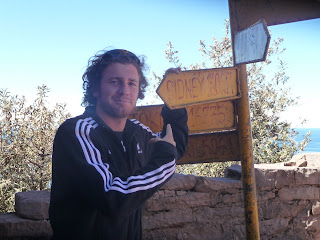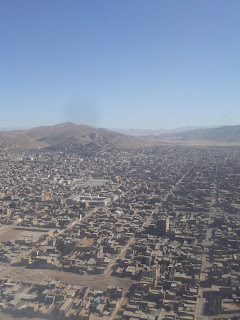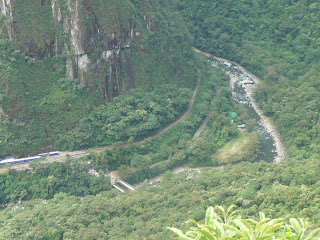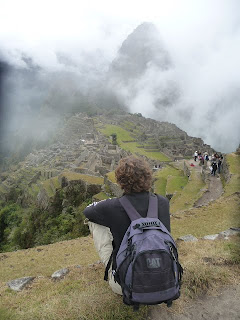Welcome to the Incas



Lima

























OSI OSI OSI OUI OUI OUI ;-)





Freundlicher Empfang in Juliaca




Aguas Calientes
Das Tor zum Machu Picchu









MACHU PICCHU :-)


Tolle Aussicht ;-)




















 Isnt it beautiful!!!!!!
Isnt it beautiful!!!!!! 
























 Südamerika ich komme....
Südamerika ich komme.... Nach einer dann doch langen Anreise von Orlando über Panama City bin ich gut in Lima angekommen. Müde und erschöpft gings zum Gruppenmeeting am Abend. 3 Kanadier, 2 Schotten, Mutter und Sohn aus Neuseeland, 2 Amerikanerinen und JEMAND aus Good Old Germany ;-)
Elard, unser Peruanischer Tourguide hat uns erzählt was uns in den nächsten 10 Tagen alles erwartet, und er hat nicht zuviel versprochen ;-) Thanks Elard
Am nächsten Tag gings mit dem Flugzeug von Lima über Cuzco nach Juliaca und dann mit dem Bus nach Puno zum Titikakasee, geiler Name, hehe...man man war das ne Reise!
In Puno angekommen wurde schon gemunkelt das wir vielleicht früher als geplant die Stadt wieder verlassen sollten, ansonsten würden wir dort feststecken und den Rest unserer Tour wohl verpassen...Ein Streik war angesagt, sprich alle Busfahrer, LKW Fahrer usw Streiken...
Der nächste Tag hat aber sehr schön angefangen, wir wurden früh morgens mit dem Fahrrad Taxi abgeholt und zum Hafen gebracht. Eine Bootsfahrt auf dem Titikakasee mit Besichtigung der Floading Inseln und Taquile Island. Nach ca 3 stündiger Bootsfahrt sind wir auf Taquile Isl angekommen, rechtzeitig zum Mittagessen hat Elard einen Anruf bekommen, wir sollen so schnell wie möglich zurück ins Hotel, Koffer oder ich halt meinen Backpack packen und den letzten Bus Richtung Cuzco nehmen, ansonsten stecken wir für unbestimmte Zeit in Puno fest!!!!!!!!!!!!!!!
Na super. Aufgegessen, zum Boot und dann das noch, das Boot war keine 2 Minuten Unterwegs dann ging der Motor kaputt und wir sind Richtung Bolivien abgetrieben, möchte mir garnicht vorstellen was passiert wäre wenn wir an der anderen Seite des Sees in Bolivien angekommen wären...
Zum Glück hat uns dann ein anderes Boot abgeschleppt, 4 Stunden Boot abschleppen, ich sags Euch was en Spass.
Kurz zusammengefasst wie es weiter ging: In Puno angekommen, wurde der erste Bus verpasst, und der zweite und letzte gerade noch so bekommen, jippi!!! Nach ca 7 stündiger Busfahrt mit mehreren Stopps (um die Steine und Bäume vom Streik aus dem Weg zu räumen) sind wir dann Nachts in Cuzco angekommen. Ein weiterer abenteuerlicher Tag mit vielen schönen Erlebnissen ging zu Ende :-)
Am nächsten Tag wurde Cuzco erkundigt, eine super schöne alte Stadt. Kleine Strassen, schöne alte Kirchen, gutes Essen und viele Touris ;-) Cuzco ist die Touristenhochburg Perus, dazu noch die Adventurehauptstadt Perus: on Bungeejumping, bis Waterrafting und Down Hill bis hinzu Skydive, alles ist hier möglich...
Nach dem Ausflug zum Secret Valley und Meerschweinchenessen (jaja die armen Haustiere, ist ja eckelhaft sagen jetzt viele, hey sorry wusste nicht das da Meerschweinchen drin war!!!!!!!!!!
;-) aber es hat geschmeckt, jammy) ging es dann mit dem Bus und dem Zug nach Aguas Calientes, dem Tor zum Machu Picchu!!!! Man hab ich mich danach gesehnt,
Machu Picchu, der absolute Hammer!!!!
Wie wird es sein, wird es so wie alle sagen und und und...nein es war besser, schöner, beeindruckender, mystischer als ich mir es vorgestellt habe!!!!!!!!!
Du sitzt da, schaust runter auf die Ruinen-Stadt, ringsrum Wolken, Berge die mit grün übersät sind und denkst einfach nur WAHNSINN!!!! Wie haben die das vor so vielen Jahren geschaft diese Stadt hier oben zu erichten?????
Ich könnt jetzt noch Stunden darüber berichten, aber um das zu verstehen was ich meine müsst Ihr das mit eigenem Auge gesehen haben...
Peru is frequently referred to as the 'Land of the Incas'. It is true that the Incas formed the greatest empire on the continent and left mysterious cities such as Machu Picchu. However, it is important to remember that the Incas were the only the last in a long series of Peruvian civilizations spanning several thousand years and the ruins of many of these earlier civilizations can also be visited. Peru is made up of three main geographical areas: the Andes, the Amazon and the desert coastal area.
Known as the City of Kings, Peru’s capital city Lima was founded by Francisco Pizarro on the Day of the Three Kings (Epiphany) in 1535. The Plaza de Armas is the heart of old Lima, and it is here you find the Cathedral, Government Palace and Archbishop’s Palace. The Cathedral dates back to the 1700s and houses the remains of the conquistador Pizarro. To get a feel for colonial Lima, take a cab to the Plaza de Armas and watch the changing of the Palace Guard in the afternoon. Walk the streets surrounding the Jirón de la Unión for great examples of Spanish-colonial architecture and to get a taste for life in a large South American city.
Located at 3830 m above sea level, Puno is the highest altitude of any place we sleep on the tour. As a result the weather can be extreme with very cold nights and a strong sun during the day (don’t worry, if you get cold, buy an alpaca sweater from the market — they are inexpensive). Puno is also known for its wealth of traditional dances: there are up to 100 different varieties, usually performed in the street processions celebrating Catholic feast days. If you are fortunate enough to be visiting at the right time you may even catch one of these celebrations. Titicaca is also the largest lake in the world above 2000m, and the views from both Amantaní and Taquile Islands are stunning.
Our first stop on Lake Titicaca is the floating islands of the Uros people. The Uros began their unusual floating existence centuries ago in an effort to isolate themselves from the Colla and Inca tribes. Sadly, the Uros language has died out, and today the islanders speak Aymara due to intermarriage with Aymara-speaking clans. Today about 300 families live on the islands, however their numbers are slowly declining.
The Totora reeds that grow in the shallows of the lake are used for making everything from the islands themselves to the model boats that the islanders sell. The islands are made up of layers upon layers of reeds; as the layers closest to the water start to rot, they are replaced with fresh reeds on top. The reeds are also used to build their boats, which if constructed well will last up to 6 months.
The people of Taquile Island’s unique culture, style of dress and lifestyle make for a memorable visit. The men of the community do all the knitting, as this is strictly a male domain, while the women do the spinning. High quality, locally knitted goods are available for purchase at various cooperatives on the island.
Cuzco is the continent’s oldest continuously inhabited city, and the hub of the South American travel network. The city attracts travellers who come not just to visit a unique destination but also to experience an age-old culture very different from their 20th century way of life; one could easily spend a week just in and around the area. Inca-built stone walls line most of the central streets and you don't have to go far to see other major Inca ruins. It is a city steeped in history, tradition and legend.
Every year Cuzco attracts thousands of travellers who come to delve into its noble but tragic past. It is the perfect base for optional explorations around the city and area as well as a range of outdoor activities. Relax and explore this fascinating city, and take time to acclimatize to the high altitude.
Cuzco’s numerous colonial churches are one of the city’s most common sights. The Cathedral was started in 1559 and took 100 years to build; it is also one of the city’s greatest repositories of colonial art. Immediately in front of the entrance is a vault containing the remains of the famous Inca historian, Garcilaso de la Vega. Also worth visiting are the churches of La Compañía, La Merced and San Francisco.
While most ruins are just outside of the city, the main ruin within is that of the Coricancha, once the Inca Empire's richest temple. Today the ruin forms the base of the colonial church of Santo Domingo. During Inca times this temple was literally covered with gold, but within months of the arrival of the first conquistadors this incredible wealth had all been melted down. It is left to the individual imagination to envision the magnificence of the original structure.
There are several good museums in Cuzco, including the Archaeological Museum, which also houses a small art museum, the Regional History Museum and the Religious Art Museum.
Located at 3830 m above sea level, Puno is the highest altitude of any place we sleep on the tour. As a result the weather can be extreme with very cold nights and a strong sun during the day (don’t worry, if you get cold, buy an alpaca sweater from the market — they are inexpensive). Puno is also known for its wealth of traditional dances: there are up to 100 different varieties, usually performed in the street processions celebrating Catholic feast days. If you are fortunate enough to be visiting at the right time you may even catch one of these celebrations. Titicaca is also the largest lake in the world above 2000m, and the views from both Amantaní and Taquile Islands are stunning.
Our first stop on Lake Titicaca is the floating islands of the Uros people. The Uros began their unusual floating existence centuries ago in an effort to isolate themselves from the Colla and Inca tribes. Sadly, the Uros language has died out, and today the islanders speak Aymara due to intermarriage with Aymara-speaking clans. Today about 300 families live on the islands, however their numbers are slowly declining.
The Totora reeds that grow in the shallows of the lake are used for making everything from the islands themselves to the model boats that the islanders sell. The islands are made up of layers upon layers of reeds; as the layers closest to the water start to rot, they are replaced with fresh reeds on top. The reeds are also used to build their boats, which if constructed well will last up to 6 months.
The people of Taquile Island’s unique culture, style of dress and lifestyle make for a memorable visit. The men of the community do all the knitting, as this is strictly a male domain, while the women do the spinning. High quality, locally knitted goods are available for purchase at various cooperatives on the island.
Cuzco is the continent’s oldest continuously inhabited city, and the hub of the South American travel network. The city attracts travellers who come not just to visit a unique destination but also to experience an age-old culture very different from their 20th century way of life; one could easily spend a week just in and around the area. Inca-built stone walls line most of the central streets and you don't have to go far to see other major Inca ruins. It is a city steeped in history, tradition and legend.
Every year Cuzco attracts thousands of travellers who come to delve into its noble but tragic past. It is the perfect base for optional explorations around the city and area as well as a range of outdoor activities. Relax and explore this fascinating city, and take time to acclimatize to the high altitude.
Cuzco’s numerous colonial churches are one of the city’s most common sights. The Cathedral was started in 1559 and took 100 years to build; it is also one of the city’s greatest repositories of colonial art. Immediately in front of the entrance is a vault containing the remains of the famous Inca historian, Garcilaso de la Vega. Also worth visiting are the churches of La Compañía, La Merced and San Francisco.
While most ruins are just outside of the city, the main ruin within is that of the Coricancha, once the Inca Empire's richest temple. Today the ruin forms the base of the colonial church of Santo Domingo. During Inca times this temple was literally covered with gold, but within months of the arrival of the first conquistadors this incredible wealth had all been melted down. It is left to the individual imagination to envision the magnificence of the original structure.
There are several good museums in Cuzco, including the Archaeological Museum, which also houses a small art museum, the Regional History Museum and the Religious Art Museum.
Machu Picchu is both the best and the least known of the Inca ruins. It is not mentioned in any of the chronicles of the Spanish conquistadors and archaeologists today can do no more than speculate on its function. The local Quechua farmers in the area knew of Machu Picchu for centuries, but it was not until an 11-year-old boy led the American historian Hiram Bingham (who was in search of Vilcabamba) to the site on July 24, 1911, that the rest of the world became aware of its existence. At that time the site was covered in thick vegetation, and Bingham and his team returned in 1912 and 1915 to clear the growth. Over the years, much work has been done on excavating and studying the site. Despite these efforts, many unanswered questions remain.
VIVA PERU!!!!!!!!!!!!!!!!!!!

















